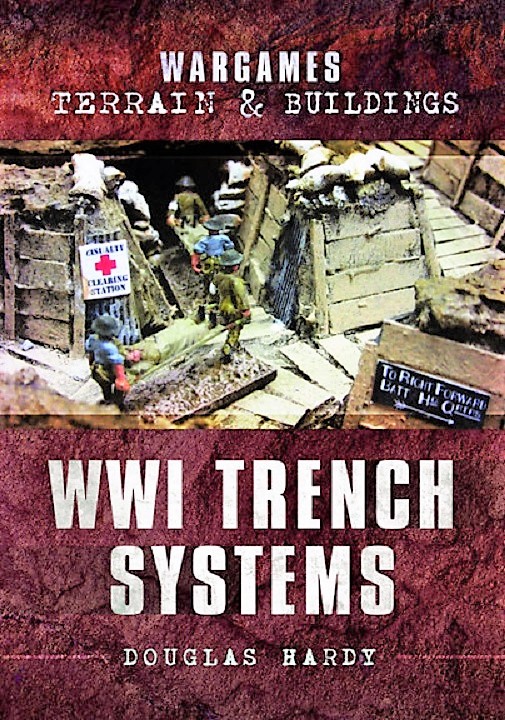Wargames Terrain and Buildings: WWI Trench Systems
Wargames Terrain and Buildings: WWI Trench Systems is one of Casemate Publishers latest offerings. Douglas Hardy, an avid war gamer, has delivered a wonderful soft cover tome on all things related to WWI trenches. After a brief introduction Mister Hardy discusses the trench system employed by Britain, France, and Germany during the Great War.
After some introduction the author goes on to discuss, in some detail, the ins and outs of designing and building your own table top trench warfare gaming area. The focus of this volume is on war gaming but the techniques he discusses are just as applicable to any diorama or vignette builder. [Fun Fact: British philosophy toward trench warfare was to use them as an offense starting point whereas the German focus viewed trenches from a defensive perspective.]
The book is divided into six chapters that focus on the specifics of those areas germane to fashioning a tabletop wargaming landscape. Those chapters are:
- Wargaming the Great War
- Materials
- Commercial or Scratch-Built
- Building and Painting Commercial Scenery
- Projects
- Researching First World War Trenches Today.
Wargaming the Great War delves into the motivation for gamers to have a gameboard on which to place their gaming in the proper context and thus enhance the experience. To paraphrase the author, the justification for a realistic, tabletop arena provides greater atmosphere and enjoyment than what otherwise might be had without a trench system.
The Materials chapter provides the reader with rather a thorough understanding of (wait for it...) the usable materials needed to construct your table top gameboard. Beginning with Styrofoam sheets (base materiel) the author goes on to mention: coffee stirrers, cocktail sticks (toothpicks in America), string, glues, matchsticks, knives and chisels, paints, sand, flock, brushes, cotton and masks. Wear a mask while you’re doing all of this as carving Styrofoam alone creates a lot of small particles that you may wish to avoid breathing.
The next two chapters (Commercial or Scratch-Built and Building and Painting Commercial Scenery) delve into the array of commercial products that are available and some of the manufacturers that trade in these items. A much larger number of manufacturers than I first imagined. Along with an extensive discussion of the various commercial trench pieces available, Mr. Hardy provides a thoughtful evaluation or the pros and cons (material, cost, usability, etc.) of each. Most helpful, particularly for the neophyte.
Additionally, there is an assessment by the author on his technique for painting either commercial products or those that you scratch-build yourself. As you might imagine the painting technique are similar with some slight variations.
Scratch-building a trench system for your wargaming needs is also covered, as are the pluses and minus of going this route. (Not unlike the issues most scale model kit builders face.) Everything from the designing the trench to the methods and materials you will need to for finish off your project.
Just a few of the items for consideration that are explained in detail when scratch-building are: Do I want a redoubt or strong point, any machine gun bunkers (Stollen, in German), where do I want to place mortar pits, how deep does no-man's land need to be, etc.? How convenient that there is already a book that details an enormous number of issues one needs to consider when going down the road or trench of scratch-building a World War One trench system.
The chapter Projects looks at those enhancements that you might wish to consider when finishing up you trench system. The items discussed range from where to place trees, barbed wire and shell holes to machine gun bunkers and artillery positions. Not only are these things treated, but the author devotes considerable time explaining how best to go about creating these embellishments.
The final chapter of Wargames Terrain & Buildings WWI Trench Systems covers the all-important issue of research. While there is nothing like visiting the actual battlefields to get the proper lay of the land that may be an issue for those that don't live in England or Northwestern Europe. Not to fret, this chapter contains a plethora of images of the present-day battlefields.
For the wargamer or scale modeler, Wargames Terrain & Buildings WWI Trench System from Casemate Publishers will make a valued addition to your library. With 250 colour illustrations on 136 pages this soft cover book has an enormous amount of information that will be of immeasurable help when it comes to either scratch building terrain for war gaming and diorama enthusiast or for simply placing your stand-alone project in the proper context.
My thanks to Pen & Sword Publications and IPMS/USA for the review copy.
Support Your Local Hobby Shop!













Comments
Add new comment
This site is protected by reCAPTCHA and the Google Privacy Policy and Terms of Service apply.
Similar Reviews